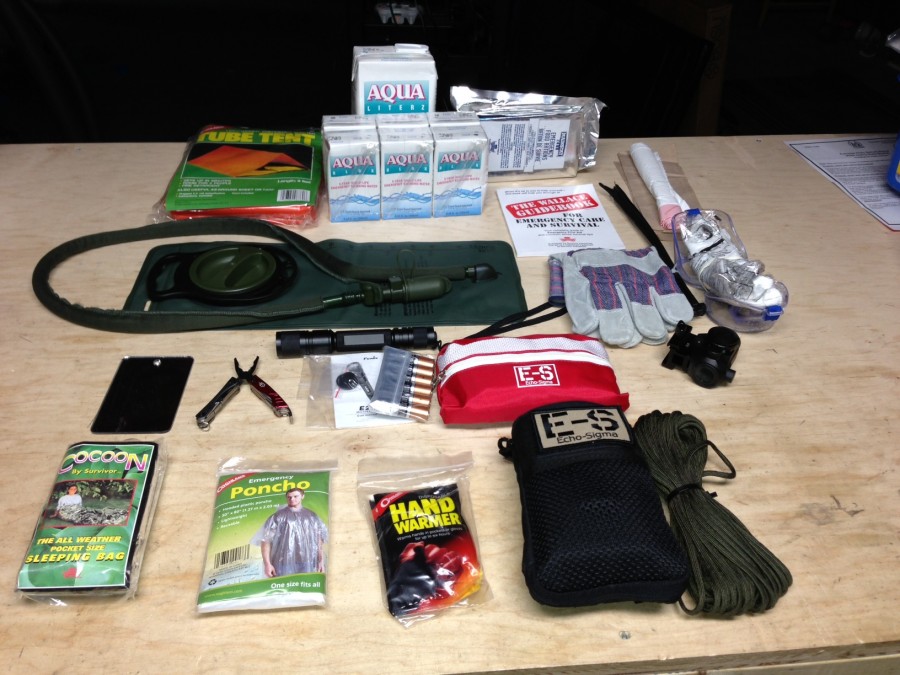 Regular readers may remember last year’s epic $200 Bail Out Bag Challenge in which RF gave Nick and Tyler $200 each to assemble a bug-out bag that they could use to survive for 24 hours in the south Texas heat. If nothing else, the video they made is fairly amusing, but from a practical standpoint, we all learned some things from the endeavor that should guide our decision-making process should we decide to make our own bags . . .
Regular readers may remember last year’s epic $200 Bail Out Bag Challenge in which RF gave Nick and Tyler $200 each to assemble a bug-out bag that they could use to survive for 24 hours in the south Texas heat. If nothing else, the video they made is fairly amusing, but from a practical standpoint, we all learned some things from the endeavor that should guide our decision-making process should we decide to make our own bags . . .
Since that time, I’ve given a fair amount of thought to what makes a good bugout bag. Obviously everyone has an opinion as to what should and shouldn’t be in your bag and the contents will likely change depending on where you live, the time of year, where you expect to find yourself, etc. In addition to home-made bags, a number of companies have taken it upon themselves to create ready-made kits full of things that they think you’ll need. Some of these bags are crap and some are well thought out. One that falls into the latter category is the Echo-Sigma Get-Home-Bag.
Echo-Sigma offers a number of ready-made bags along with individual components should you just want to fill out your existing bag with some new components. The ready-made bags range in cost and purpose and include:
The Runner ($125) is a compact and relatively light pack (9 lbs.) that includes critical supplies to keep you mobile.
The Get-Home-Bag ($249) is designed to be stored in your car and provide you with enough gear and supplies to survive for 2-3 days as you make your way back home or another place of safety. This one clocks in at about 16 lbs., much of it due to the 2.5 liters of water that’s included.
The Bug Out Bag ($499) is their premier personal survival kit. It’s a heavy load (33 lbs.), a third of that due to 5 liters of water, but it includes pretty much everything needed to survive on your own for several days.
In addition to the personal kits, Echo-Sigma also offers a nearly 100 lb. Emergency Roll-Away kit that’s designed to provide all of the necessary survival supplies for two people for 3-10 days.
I’d heard a lot of good things about Echo-Sigma kits, so I decided to purchase one of their Get-Home-Bags as I felt that was the ideal intersection of price, weight, and supplies. Depending on who you order the kit from (both Amazon and Brownells carry them, or you can order direct from Echo-Sigma) there are a number of colors available. Black, Coyote Brown, and Red are standard colors. A-TACS and Multi-cam are offered as $40 options. Since I intend this to be an emergency pack, I wanted something visible, so I opted for Red.
The Condor Outdoor Assault pack that Echo-Sigma uses is a good starting point. If you were to go out and procure your own, you would find that this accounts for about $45-$50 of the price, more for the A-TACS and Multicam flavors. The bag has a fairly extensive number of interior and exterior pockets which Echo-Sigma puts to good use arranging all of the gear that’s included.
One of the advantages of ordering directly from Echo-Sigma is the ability to upgrade some of the standard items. You can choose a different ration/water kit, upgrade the included flashlight, upgrade or add another multi-tool or add a full blown knife, folding shovel, and/or tomahawk. To keep things simple, I went with the standard kit. To gauge its value, I’m going to list the approximate price that I found for each component on Amazon.com. You may be able to find these items for less, but we’ll use it as our benchmark.
The kit includes a Condor Outdoor 2.5 liter hydration bladder ($15) that fits into a pocket on the back of the pack. Tools include a Gerber “Vise” Multi-Tool with pliers, knife, screwdrivers, etc. ($13) and an E21 flashlight by Fenix ($31). The Gerber Vise may be one thing worth upgrading as it’s fairly small – about three inches or so and is described as a “keychain” tool.
Survival Gear Includes:
- 50 Feet of Military Grade 550 Paracord ($5 value)
- 10 Extra Large Zip Ties ($1?)
- 1 Coghlan’s Emergency Tube Tent ($10)
- 1 Emergency Poncho ($4)
- 1 Plexiglass Mirror for signaling help ($4)
- 1 Thermal Sleeping Bag Cocoon by Survival Industries ($14)
- 6 Premium AA Alkaline Batteries (guaranteed fresh for 7 years) ($4)
- 1 Pair Leather Work Gloves ($13)
- 2 N95 Rated Respirator Masks ($1)
- 1 Pair of Protective Goggles ($5)
- 2 Hand Warmers by Coghlan’s ($3)
Total cost of items discussed so far $168.00 Echo-Sigma also includes some items with their own brand names on them. The first is their 1-3 day Arid provision pack that includes 2,400 calories of ration bars (6 bars at 400 calories apiece) and 2.5 liters of boxed water with a five year shelf life. ($16).
The next specialty item is a compact first aid kit ($25) which includes about 68 various pieces. When I compare it to other first aid kits available through Amazon, I’d say the price is about what you would pay for a similar kit from other vendors.
The final item is the compact survival kit ($50) which includes:
- 1 Compass
- 1 Emergency Whistle
- 1 Emergency Blanket by Coghlan’s
- 1 BIC Brand Butane Disposable Lighter
- 1 Magnesium Fire Starter with Flint Striker
- 40 Waterproof Matches by Coghlan’s
- 1 Tinder Kit by Coghlan’s with Flint Striker
- 50 Inches Duct Tape
- 1 Bottle of Water Purification Tablets by Coghlan’s
- 2 Chemical Light Sticks by Coghlan’s
- 2 BIC Brand Ball Point Pens
- 1 Pad of Paper
- 1 Set of Earplugs
A search of similar gear turned up Adventure Medical Kit’s more fully-featured Pocket Survival Pack Plus for about the same price, so I’d say the one from Echo-Sigma is maybe about $5- $10 or so heavy in terms of value. Let’s say it’s contents are worth about $40 – $45.
Adding everything up, the total value of the kit comes to $249 – $254, which, oddly enough is exactly what this kit costs. So, while you may not be getting a super bundle deal, you are not getting ripped off either. You should also consider a few other things.
First of all, assembling your own kit takes time. Me, I don’t mind paying someone else a bit to do the legwork. Secondly, if you have to order the pieces from different vendors, you are going to pay multiple shipping and handling charges, which will drive the cost up. Third, for someone who doesn’t know where to start, but wants a well configured kit you can hardly go wrong with one of these.
As with most tactical gear, one needs to consider the mission. The mission of the Get Home Bag is to get you home or to a place of safety where presumably you will have more provisions. It is not intended to be an extended survival bag (although it could function as one assuming you have access to food and water once the included provisions run out).
The kit is designed to help you navigate, signal for help, secure warmth (three different means of starting a fire are included), protect you from the elements (sleeping bag, tube tent), deal with minor medical issues, provide a couple of days provisions, and protect you from semi-hostile atmospheric situations (gloves, goggles, mask). The folks at Echo-Sigma have done a great job of including just the things you need while keeping weight and cost as low as possible. That said, nothing is perfect, so in addition to the contents of this kit, I’d consider adding a few things. First of all, you need a proper knife. As Crocodile Dundee said, “That’s not a knife. This is a knife”
The Cold Steel Bowie Blade Bushman Fixed Blade Knife. 7 inches of razor sharp knife that weighs only 10 oz and costs a mere $24. Sure, you will need to put a light coat of oil on it to guard against rust and it may not be a great every day blade, but in a survival situation, it will add a lot of value without weighing you down.
Next, as I mentioned, I’d opt to upgrade the keychain Gerber tool to a more fully featured one. Unfortunately, Echo-Sigma wants $50 to upgrade to the SOG S44 tool. Given the fact that you can purchase an S44 on Amazon for about $40, I’d be inclined to skip the upgrade through Echo-Sigma, buy the S44 through Amazon, and stick the Gerber dime on my keychain where it belongs.
Finally, If you live in a cold climate (or one that gets cold from time to time) I’d add this:
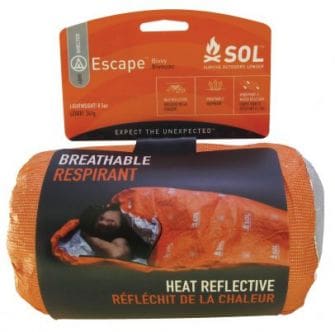 The Adventure Medical Kits SOL Escape Bivy Bag ($35) that will keep you nice and toasty warm but still breathes which means you don’t trap condensation and get wet.
The Adventure Medical Kits SOL Escape Bivy Bag ($35) that will keep you nice and toasty warm but still breathes which means you don’t trap condensation and get wet.
Fortunately, the Get-Home-Bag has enough space left over to hold these items along with anything else you might want to add (such as maybe a gun and some ammo). It’s compact, fairly light weight given what you get and should be enough get you home.
Specifications:
Echo-Sigma Get-Home-Bag
Price: $249
Ratings (out of five):
Function: * * * *
With a few added accessories, this bag includes pretty much everything you need to get to a place of safety. Unlike some other products, Echo-Sigma didn’t take a “kitchen sink” approach and load you down with lots of useless crap. Every item is well considered for the mission. You have almost everything you need and nothing you don’t.
Ease of Use: * * * * *
You pull this bag out of its box and its loaded and ready to hit the road. No need to take lots of individual pieces out of their own wrappers like some kits have. If I recall correctly, the food and water come in a separate box to protect it and prevent leakage, but it is clear from the empty main compartment of this bag where it needs to be stowed.
Value: * * * *
Sure, you can probably assemble an identical kit for about what it costs to purchase this one, but is that really a bad thing? Why do we always have to associate bundled products with price discounts? Instead, look at it this way – you hired a wilderness consultant to prepare a survival bag for you. Instead of charging you for his services, he negotiated discounts with the equipment makers, bought all of the products, put them together in a bag and charged you what you would have paid had you done all of the legwork yourself. Pretty decent value if you look at it that way.
Overall: * * * *
I’m knocking one star off because I think this bag should have included a couple of critical items by default. A better multi-tool and a knife like the Cold Steel one would have bumped the price up to just under $300, but it would have been worth it. Then again, these omissions are easy to remedy and Echo Sigma was clearly trying to shoot for a $250 price point which seems sensible to me. Add the items I suggested and you end up with a kick ass survival kit.

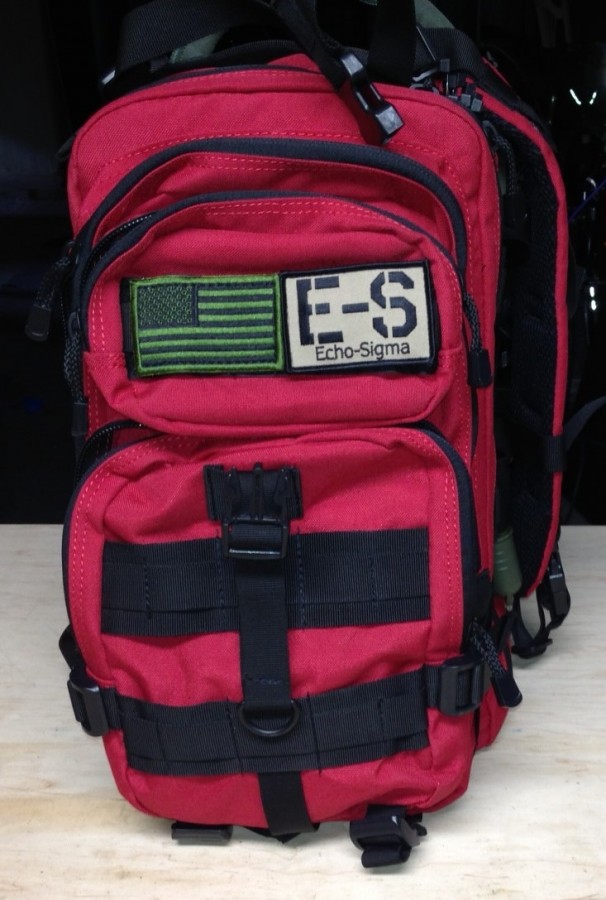
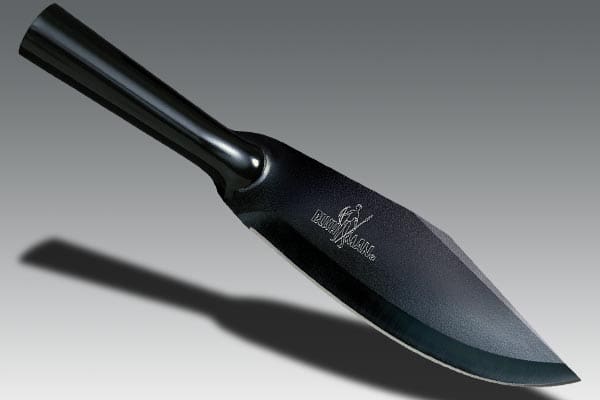
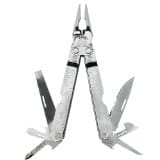



“RF gave Nick and Tyler $200 each to…survive for 24 hours in the south Texas…”
You don’t have any $200 hotel rooms in south Texas?
I have two Fox Tactical medium transport bags, they are the exact same thing as this bag and I love them. I put together my own kit though.
To me, that’s a GTFOD kit…. the “D” meaning “Dodge”, in case you were wondering.
Shouldn’t that be GTFOOD?
Not if you shorten “out of” to “outa”.
Gtf outta dodge…
Proper grammar? Where we’re going we don’t need proper grammar (this is the internet!)
Grammar? We don’ got to show you no steenkin’ grammar!
One of these days I’m going to get around to assembling something like this. One of these days.
Matt. You live in hurricane country. Today is the day to at least get started on your car kit.
Include an umbrella. If you can’t walk out, you can fly!
Matt as Mary Poppins. Now that’s some funny stuff there.
Get to it! The best time to prep is when there is no emergency, because you’ll be SOL otherwise.
Agree 100% we have emergency bags for all in the family, plus I have a get home bag in my trunk. I also used to carry a folding scooter in my trunk just in case, that was when I lived 40 miles from work, I think I can cover 8 miles a lot quicker.
For it to work with Matt, that umbrella better be the size of an ’80s satellite dish! Sorry bro just getting you back for the other day.
Great kits. You are spot on when you describe differences in where you are and time of year. Just having a small kit like this has made the difference between having a rough time and being comfortable.
Great article!
Years ago when I lived in California earthquake country I sweated over putting together a kit such as this until I came to the realization that everywhere I was, there was my car! I couldn’t think of any time that I wasn’t within a few hundred yards, at most, of where I left that car, so I finally realized also that I didn’t necessarily need a kit light enough that I could hump it all the way home. YMMV.
Everyone should have a multipurpose emergency kit in their vehicle and home. In my car I have clothes, gloves and boots. I also have a walking/whomping stick. 2 poly tarps and rope. First aid kit and fire bottle.
My kit has: stainless steel sierra cup. small stainless steel cook pot with lid and bale. 2 quart GI canteen with shoulder strap. Food. Sanitation aids. Emergency candles. LED headlight. SAK and belt knife. Butane lighters, life boat matches and swedish fire steel. GI blanket. Paracord. Rain jacket. Small first aid kit.
Have to get: Foam sleeping pad and milspec poncho.
Wednesday last my wife and I left the bay area and drove to Bodega Bay. On a road trip like this I will add a .38 and ammo to my trunk kit.
Man, It’s gotta be a drag to stow ammo in the trunk.
Up here, I’ll just jam another pistol betwixt the seats. Or better, toss the P-90 on the back seat.
I can’t stow the weapon or ammo in the trunk. I just use them on road trips. I’m mostly retired, but when I work it’s at a public school. And I frequently pick my grandkids up from school. In California having guns and ammo in your car on a school property is good for a felony. Sucks, but there it is.
My next prep is an eton radio and katadyn water filter. Or I’m wondering if it’s better to get a big berkey household unit.
If you’re not already familiar with it, check out the Sawyer Pointeone (I think that’s how it’s spelled) system.
A lot more compact and it apparently fits on Platypus bags and other bottles, though I haven’t tried that with mine.
I always carry a full range box (gun cleaning) gear, a full tool box auto, rope, air pump, spin tire iron, and firearms plus ammo.and first aid kit, get home kit, maps,compass NEVER GET lost……..
Where this thing falls down as far as I’m concerned is that it LOOKS so much like a bug out bag.
In a desperate situation with desperate people, that thing practically screams “look at me, I’m full of awesome gear! Hit this guy over the head and take me!”
I know, I know, that’s what the gun is for. I’d rather be a little less cognito and save myself the trouble of having to kill a guy over my waterproof matches.
Everyone should screw these pre-packaged survival kits. If you are really serious about assembling a SHTF small bag, buy and read Cody Lundin’s book, “98.6 Degrees: The Art of Keeping your Ass Alive”. You can assemble your own kit with many items you already have (and the ones you don’t won’t cost you an arm and a leg), plus the book explains how to USE the stuff you would need in an emergency.
My $.02.
good advise, thanks!
+1. KISS. Shelter. Water. Food. Fire.
More important than tools is the practice in using them.
BSA 10 Essentials is a good list.
http://scoutingmagazine.org/2013/02/the-10-essentials/
It should be offered in My Little Pony Pink
Not a bad idea. No one is going to try and jump a dude with a desparate look on his face and carrying a pink backpack
Dollars to donuts Fluttershy’s a prepper.
Now I need one of those too. Gee, thanks.
Nice article..
I’d recommend leatherman wave/surge and a esse/surviveknives/Bark river in BOB..
Those who are SERIOUS about BOB, here is your guide:
http://zombiehunters.org/forum/viewtopic.php?f=14&t=36016
For those of you that don’t have time to put together your own kit, one of these might work in a pinch. However, if you do have the time or you want something more robust, you can put together a solid kit for a similar if not better price point that will blow these kits out of the water. One of the problems I have always had with premade kits is they always include items I don’t need and I would always have to add some items I do need. I would rather just build the whole thing from the ground up myself.
A few things to note about this kit for those not in the know.
1. Half of this kit is Coghlans brand gear. Coghlans is the brand that Wal Mart stocks in the camping aisle as a cheaper alternative to the already cheap Colman and Ozark Trail brand camping equipment. That isn’t to say that all their stuff is junk, but it is definitely on the lower end of the quality scale. Also, you can usually find the Coghlans gear at Walmart for several dollars cheaper than Mr. Barrett found them on Amazon.
2. The leather gloves that are included in this kit are pretty much garbage. I don’t know what Mr. Barrett was looking at when he arrived at a $13 value, but you can have these exact same gloves in a three pack for $10 on Amazon. I happen to know that my local Harbor Freight and Tool carries the identical gloves for $3.99. The fingers are big and floppy and you have absolutely ZERO dexterity in them. They might work ok if you are trying to climb through a barbwire fence or something, but I would rather go with something a little more versatile. Another issue with these gloves, since this is a gun community, is that if you had to go for your gun while wearing these, good luck getting your finger in the trigger guard. Legit tactical operator gloves are probably the best choice. However, if you are like me and have an aversion to spending a ton of money stuff that is going to sit mostly unused in the trunk of your car, I would recommend a standard pair of $15 Mechanix Wear Gloves. Way more resilient and you can actual do stuff with them with some deftness.
3. If you are considering the premium Bug Out Bag that they are offering, I caution you to consider the weight. The 33 lbs of weight isn’t the problem. What is the problem is the bag that they put it in. It is a “Three Day Pass” backpack by Sandpiper of California which retails for about $55. Two things: This pack has NO internal or external rigid frame and NO padded waist belt to support the weight on your hips. A couple hours of carrying this bag around with 30 plus pounds of gear in it and your shoulders and back are going to be killing you and you are going to be miserable. Second, I don’t how much of cost these play in the overall price of the kit, but you can have an infinitely superior bag from LA Police Gear for $45.
http://www.lapolicegear.com/lapg-operator-backpack.html
I have this pack and it is awesome. It is my go anywhere bag. It has some padding on the belt and it has a removable rigid panel that adds some structure to the pack making it much more comfortable to carry loads. However, if you plan to carry more than 35 or 40 lbs of gear, I recommend you jump up to a legit backpacking pack with a frame. A cheap one can be had for $80.
I know I have rambled and there is so much more I could say, but let me leave you with this. If you are going to build your own kit, buy all of your gear BEFORE your buy your bag. How much gear you have determines what type and size bag you need. I see people make two mistakes all the time; they find an awesome bag and then either can’t fit all their gear in it or they have extra room after they put their gear in and they are tempted to add more gear because they can and extra weight is a killer.
Late addition to the tips category: 1) If you REALLY need to start a fire in any condition, including rain/driving wet snow, add half a dozen road flares to your car trunk/BOB. In addition to being useful for emergency breakdown signals, that 15 minutes of 2000+ degrees flame will start wet tinder going without a problem.
2) For you OFWGs and smaller-frame persons, add a folding carry-on airport-style luggage cart to your trunk. They don’t use much space, and if you get the version with the largest wheels you can find, they will roll along a paved road with a lot less effort than carrying a 33lb pack and a gallon or two of water. BONUS: when you find that incredible deal on 5000 rounds of .223 at the gun show, the luggage cart will help you get it to your car without a hernia.
Idaho. I’ve toyed with the idea of getting a jogging stroller for my emergency kit. The used stores have them at good prices and they would handle off road quite well, I believe.
Good thought. On my longer trips to the back end of nowhere, I put a fold-up 2-wheel game cart in the truck. A bit heavy, but they have solid tires and will hold several hundred pounds – 5 gallons of water not a problem. The stroller might work better at keeping gear in the cart – I strap a backpack to my cart so the smaller stuff won’t fall off, and I also have a backpack (just in case).
Bright red backpack -> can anyone say, “Left 4 Dead”?
Video game references aside, I’m considering picking one of these up. Shoutout to TTAG.
Be interesting to see a reprise of the 2012 bugout challenge – using the gear you suggest/assemble as a bug home from work. In an empty/earthquake/hurricane scenario where power out and roads blocked.
“Regular readers may remember last year’s epic $200 Bail Out Bag Challenge in which RF gave Nick and Tyler $200 each to assemble a bug-out bag that they could use to survive for 24 hours in the south Texas heat.”
Pretty much anyone can survive 24 hours without any kind of bug-out-bag.
All you need is a bottle of water.
If I had to pick one thing- it would be a knife. You can make/get the rest with that, but some of those are hard to acquire skills that take practice.
I have one of these in my truck I put it together myself. I have warming layers for in the winter, extra pair of combat boots (broke in), camel pak with filter, 3 liters of water, 100 rounds of 45 ACP 230 JHP w/ kimber 1911 & 3 mags of 8 rounds, Serpa paddle holster, first aid kit with trama pouch, solar blanket, cigarettes (for barter), extra cash, 550 cord 100 feet, ka-bar, fire starting material cotton balls soaked in vaseline with waterproof matches, lightsticks, LED flashlight with extra batteries, toliet paper (the quilted kind no leaves for me), duct tape (because it can fix anything), (3) MRE’s , multitool, and (3) pair extra socks.
two empty water bottles.
This sucker isn’t light but a 35 – 40 lb pack is better to carry and be prepared than having nothing and have to survive.
what I plan to add to it:
The Solar Bivy to replace the space blanket
Portable foldable solar panel for pack attachment to charge my iPhone and batteries
E-tool (cause digging with your hands suxs)
Poncho and Poncho Liner for shelter.
Better fire starting kit.
ten feet of surgical tubing 1/2″ diameter (for urban survival. This can be used to syphon gas from abandoned cars)
I don’t agree, read that:
http://www.thefirearmblog.com/blog/2013/05/30/echo-sigmas-home-bag/
Comments are closed.